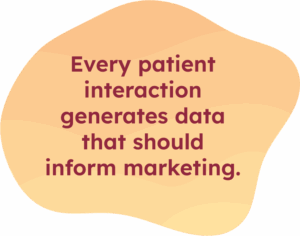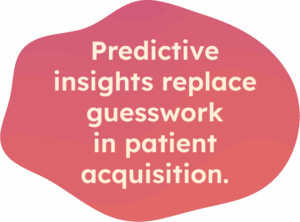Healthcare marketing teams face a peculiar challenge. They can tell you exactly how much they spent to acquire each new patient, which campaigns performed best, and how many appointments were scheduled from last month’s digital ads. But ask them what happened to those patients six months later, and the trail goes cold.
This isn’t a failure of marketing teams; it’s a structural problem. The data that determines whether marketing efforts actually succeed lives in completely different systems from the metrics that marketing departments track. Patient satisfaction scores, safety outcomes, and retention rates remain invisible to the teams responsible for bringing patients through the door.
The result is a kind of strategic blindness where marketing success gets measured by activities that represent only the beginning of the patient relationship, not the outcomes that actually matter for organizational growth.
The Problem with Marketing in Isolation
 Most healthcare marketing operates in what could be called a “front-end bubble.” Teams focus on awareness, lead generation, and initial patient acquisition, but lack clear visibility into what happens after patients enter the system. They might celebrate a successful campaign that brings in 100 new patients without knowing that 30 of those patients had negative experiences that led them to leave within six months.
Most healthcare marketing operates in what could be called a “front-end bubble.” Teams focus on awareness, lead generation, and initial patient acquisition, but lack clear visibility into what happens after patients enter the system. They might celebrate a successful campaign that brings in 100 new patients without knowing that 30 of those patients had negative experiences that led them to leave within six months.
This isolation creates several problems. Marketing campaigns might inadvertently promise experiences that the organization can’t consistently deliver. Patient acquisition costs appear lower than they actually are because churn costs weren’t factored into marketing ROI calculations. And perhaps most importantly, marketing teams miss opportunities to leverage positive patient experiences and safety outcomes as authentic differentiators in their messaging.
Consider a common scenario: a marketing team launches a campaign highlighting the organization’s commitment to patient-centered care. The campaign performs well, driving increased appointment requests. But suppose the marketing team doesn’t have visibility into patient satisfaction scores, complaint trends, or safety metrics. In that case, they can’t know whether the organization is actually delivering on the promises being made. Worse, they might continue promoting messaging that creates unrealistic expectations.
What Integration Actually Looks Like
Healthcare organizations that successfully integrate marketing with patient experience and safety don’t just share data across departments. They change how they think about patient relationships and marketing success.
These organizations recognize that every patient interaction generates data that should inform marketing strategy. Patient feedback reveals which services truly differentiate the organization from competitors. Safety metrics identify areas where the organization excels and can be authentically promoted. Experience scores help marketing teams understand which patient segments are most likely to become long-term advocates.
The integration shows up in practical ways. When marketing teams have real-time access to patient satisfaction data, they can adjust messaging to reflect actual strengths rather than assumed ones. And when they can see safety performance metrics, they can create campaigns around genuine clinical excellence rather than generic quality claims. Once they understand which patient experiences drive the highest lifetime value, they can optimize acquisition strategies accordingly.
This approach transforms marketing from a purely promotional function into a strategic connector between organizational performance and patient expectations.
The Data Connection Challenge
The biggest barrier to this integration isn’t disagreement about its value. Most healthcare marketing leaders understand that patient experience and safety data would make their strategies more effective. The challenge is practical: this information typically lives in separate systems that don’t communicate with each other.
Patient feedback might be collected through one platform, safety data tracked in another, and marketing performance measured in a third. Even when teams want to connect these insights, the manual work required to synthesize information across systems makes it impractical for day-to-day decision making.
This fragmentation forces marketing teams to make decisions based on incomplete information. They might double down on acquisition channels that bring in patients who are likely to have poor experiences, or miss opportunities to promote genuine strengths. They might continue messaging strategies that don’t align with actual organizational capabilities.
The Compliance Complexity
Healthcare marketing faces regulatory requirements that don’t exist in other industries. HIPAA compliance, research ethics standards, and various state regulations create legitimate concerns about how patient data can be collected, stored, and used in marketing activities.
These compliance requirements often lead organizations to err on the side of caution by keeping systems completely separate. Marketing teams operate with anonymized, aggregated data that provides little actionable insight, while detailed patient experience and safety information remains locked in clinical systems.
But compliance doesn’t require complete isolation. Organizations can integrate these functions while maintaining appropriate privacy protections and regulatory compliance. The key is implementing processes and systems designed with healthcare’s unique requirements in mind from the ground up.
The ROI Reality Check
 When marketing, patient experience, and safety data remain in silos, healthcare organizations struggle to understand true marketing ROI. They might calculate cost per patient acquired, but they can’t easily determine the lifetime value of those patients or the long-term impact of different acquisition channels.
When marketing, patient experience, and safety data remain in silos, healthcare organizations struggle to understand true marketing ROI. They might calculate cost per patient acquired, but they can’t easily determine the lifetime value of those patients or the long-term impact of different acquisition channels.
Organizations with integrated systems often discover that their most expensive acquisition channels actually deliver the highest-value patients when retention and satisfaction are factored in. They might find that certain messaging strategies attract patients who are more likely to become advocates and generate referrals. They might identify safety or experience strengths that could differentiate their organization in competitive markets, but were never leveraged because marketing teams didn’t have access to the data.
This comprehensive view of marketing performance enables more strategic resource allocation and more authentic differentiation strategies.
Building the Connections
Creating integration between these departments requires more than just technology solutions. It requires organizational commitment to breaking down traditional departmental boundaries and sharing information across functions.
The most successful implementations start with leadership alignment around the value of integration. When marketing directors, patient experience leaders, and safety officers understand how their work connects and supports shared organizational goals, they’re more likely to invest in the systems and processes that make integration possible.
Technology plays a crucial role, but it’s not just about having the right platforms. It’s about having systems designed to serve multiple functions while maintaining appropriate compliance and privacy protections. The most effective solutions enable marketing teams to access patient experience and safety insights without compromising patient privacy or regulatory compliance.
Training and change management are equally important. Marketing teams need to understand how to interpret and act on patient safety and experience data. Safety and quality teams need to understand how their insights can strengthen marketing strategies and messaging.
Letting Technology Work for You
This is where modern technology becomes a game-changer. The sheer volume of patient feedback, safety reports, and experience data that healthcare organizations generate daily would be overwhelming to analyze manually. But AI and sentiment analysis tools can process thousands of patient comments, survey responses, and feedback forms in minutes, identifying patterns and trends that would take human teams weeks to uncover.
 These technologies don’t just aggregate data; they provide context. AI can distinguish between a patient who mentions “waiting” as part of positive feedback about thorough care versus one expressing frustration about delays. It can identify emerging themes in patient feedback before they become widespread complaints, allowing organizations to address issues proactively.
These technologies don’t just aggregate data; they provide context. AI can distinguish between a patient who mentions “waiting” as part of positive feedback about thorough care versus one expressing frustration about delays. It can identify emerging themes in patient feedback before they become widespread complaints, allowing organizations to address issues proactively.
For marketing teams, this allows for an important shift from reactive to predictive strategies. Instead of waiting for quarterly reports to understand patient satisfaction trends, they can access real-time insights about which services generate the most positive sentiment, which patient touchpoints create the strongest emotional connections, and which aspects of care patients value most.
The platforms that excel in this space integrate these AI capabilities with compliance frameworks built specifically for healthcare. They ensure that sentiment analysis and data processing happen within HIPAA-compliant environments while still providing marketing teams with the actionable insights they need to create more effective campaigns.
The Strategic Advantage
 Healthcare organizations that successfully integrate marketing, patient experience, and safety create sustainable competitive advantages that are difficult for competitors to replicate. Their marketing becomes more authentic because it’s based on actual organizational strengths. Patient acquisition becomes more efficient because they can identify and target the patients most likely to have positive experiences. Their reputation management becomes proactive because they can identify and address issues before they impact public perception.
Healthcare organizations that successfully integrate marketing, patient experience, and safety create sustainable competitive advantages that are difficult for competitors to replicate. Their marketing becomes more authentic because it’s based on actual organizational strengths. Patient acquisition becomes more efficient because they can identify and target the patients most likely to have positive experiences. Their reputation management becomes proactive because they can identify and address issues before they impact public perception.
Perhaps most importantly, this integration creates a feedback loop that drives continuous improvement across all three areas. Marketing insights inform patient experience improvements. Patient experience data reveals new marketing opportunities. Safety performance becomes a genuine differentiator rather than a compliance requirement.
Moving Forward
With this in mind, marketing becomes less about convincing patients to choose you and more about ensuring that the patients you attract are the right fit for what you actually deliver. Growth strategies focus on lifetime value rather than just initial acquisition. And success gets measured not just by how many new patients walk through the door, but by how many of them stay, improve, and recommend your organization to others.
This shift requires investment in systems, processes, and organizational culture. But for healthcare marketing leaders willing to break down silos and embrace integration, the opportunity to create more effective, more authentic, and more strategic marketing approaches has never been greater.











